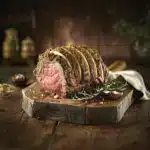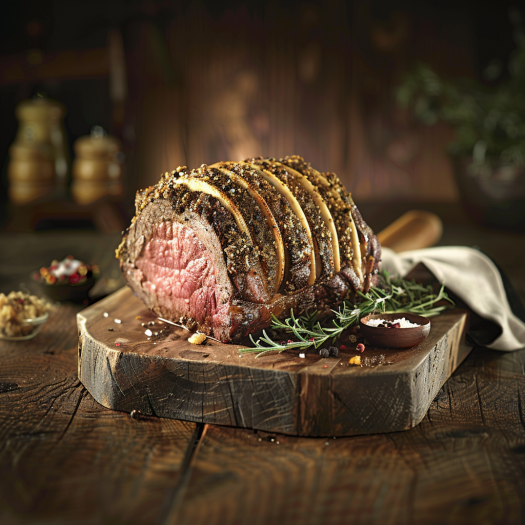There’s something magical about the aroma of a perfectly seasoned prime rib roasting in the oven.
As the scent fills the air, it builds anticipation for a meal that promises to be tender, flavorful, and unforgettable. Whether you’re hosting a special dinner or simply indulging in a treat-yourself moment, getting the rub right can transform a good roast into a masterpiece. The secret? A thoughtful blend of spices and herbs that complement the beef’s natural richness without overpowering it. Here’s how you can create the ultimate prime rib rub recipe to wow your taste buds and your guests.
Why a Prime Rib Rub Matters
Enhancing Flavor and Texture
When it comes to prime rib, the seasoning isn’t just an add-on; it’s an essential. A well-made rub enhances the meat’s natural flavors while creating a delightful crust that adds texture and visual appeal. Salt acts as a flavor amplifier, while herbs and spices bring layers of complexity, turning every bite into a flavor-packed experience.
Beyond taste, the rub plays a pivotal role in ensuring the meat’s texture is spot on. Salt helps tenderize the roast, breaking down proteins to make each slice succulent and juicy. The spices and herbs, when toasted during cooking, form a crust that locks in the meat’s moisture and juices, delivering a melt-in-your-mouth experience.
Sealing in Juiciness
The crust created by a rub isn’t just about aesthetics—it’s a moisture barrier. As the prime rib cooks, the rub hardens slightly, trapping the juices inside the roast. The result? Meat that’s bursting with flavor and juiciness in every bite.
Ingredients for the Best Prime Rib Rub
Essential Ingredients
A great rub starts with high-quality ingredients. Here’s a breakdown of what you’ll need and why each element matters:
| Ingredient | Amount | Purpose |
|---|---|---|
| Kosher Salt | 2 tbsp | Enhances flavor and tenderizes meat |
| Fresh Black Pepper | 2 tbsp | Adds a subtle, peppery kick |
| Garlic Powder | 1 tbsp | Contributes savory, earthy notes |
| Onion Powder | 1 tbsp | Rounds out the flavor profile |
| Fresh Rosemary | 2 tsp (chopped) | Brings a fragrant, herbal element |
| Thyme | 2 tsp | Adds a woodsy, aromatic touch |
| Smoked Paprika | 1 tsp | Introduces a smoky sweetness |
| Cayenne Pepper | ½ tsp | Adds a mild heat (optional) |
Optional Additions
Want to elevate your rub? Consider these optional ingredients for extra depth:
- Brown Sugar: A hint of sweetness balances the saltiness and creates a caramelized crust.
- Dijon Mustard: Acts as a binder for the rub while adding a tangy flavor.
- Ground Coffee: For a bold, earthy note that pairs surprisingly well with beef.
Step-by-Step Guide to Preparing Your Rub
Creating your rub is straightforward and satisfying. Here’s how to do it:
- Measure Your Ingredients: Accuracy matters, so measure each ingredient carefully.
- Combine Thoroughly: In a mixing bowl, combine all the ingredients, ensuring an even blend.
- Store for Later Use: If not using immediately, transfer the mixture to an airtight container. Stored in a cool, dry place, your rub will stay fresh for up to three months.
Applying the Rub for Maximum Flavor
Preparation Steps
The way you apply the rub can make or break the final outcome. Follow these steps for a foolproof method:
- Dry the Meat: Pat your prime rib dry with paper towels to help the rub adhere properly.
- Generously Coat the Meat: Rub the mixture evenly over the entire surface, ensuring every nook and cranny is covered.
- Let It Rest: For optimal flavor penetration, allow the seasoned meat to rest in the refrigerator for 12–24 hours.
Pro Tip: Room Temperature Cooking
Take the seasoned prime rib out of the refrigerator an hour before cooking. Letting it reach room temperature ensures even cooking, which is crucial for a large cut of meat.
Cooking Tips for the Perfect Prime Rib
Ideal Temperatures
Cooking prime rib to the perfect doneness is an art. Use a meat thermometer to monitor the internal temperature:
- Rare: 120–125°F (49–52°C)
- Medium-Rare: 130–135°F (54–57°C)
- Medium: 140–145°F (60–63°C)
Remember, the roast will continue to cook as it rests, so pull it out of the oven 5–10°F below your target temperature.
Resting Time
Once your prime rib is cooked to perfection, resist the urge to cut into it immediately. Let it rest for at least 20 minutes. This allows the juices to redistribute, ensuring each slice is as juicy as the last.
Prime Rib Rub Variations
Experimentation is the spice of life! If you want to mix things up, try these rub variations:
Classic Herb Rub
A simple yet flavorful combination of rosemary, thyme, oregano, and sage.
Spicy Cajun Rub
For a kick, add cayenne pepper, chili powder, and smoked paprika to your rub.
Coffee-Crusted Rub
Ground coffee, brown sugar, and black pepper create a bold, earthy crust that’s perfect for adventurous palates.
FAQs About Prime Rib Rub Recipes
What is the best prime rib rub for a smoky flavor?
For a smoky twist, use smoked paprika as the base of your rub. You can also add a touch of liquid smoke for extra depth.
Can I make the rub in advance?
Absolutely! You can prepare your rub ahead of time and store it in an airtight container for up to three months.
How long should I let the rub sit on the meat?
For the most flavorful results, let the rub sit on the meat for at least 12 hours or overnight.
Do I need to use oil with the rub?
Oil isn’t necessary, but you can use a small amount of olive oil as a binder to help the rub stick to the meat.
Conclusion
A perfectly seasoned prime rib is more than just a dish—it’s an experience. By taking the time to create and apply a thoughtful rub, you’re setting the stage for a meal that will leave a lasting impression. Whether you stick to the classic recipe or experiment with bold variations, this guide equips you with everything you need to craft a prime rib rub recipe that’s worthy of any occasion. So go ahead, roll up your sleeves, and get ready to create a masterpiece!
If you’re loving this grilled chicken wrap recipe and looking for more versatile, mouth-watering dishes, why not explore some other delicious options? For a unique breakfast treat, try this Authentic Mexican French Toast Recipe, which combines traditional flavors with a sweet twist. Need a guide to elevate your desserts or snacks? Check out this comprehensive Cream Cheese Filling Guide for tips on making rich, creamy fillings for pastries and more. Hosting a gathering? Impress your guests with an easy yet elegant Cheese Cracker Platter that’s perfect for any occasion.

Ultimate Prime Rib Rub
Ingredients
- 2 tbsp Kosher Salt
- 2 tbsp Fresh Black Pepper
- 1 tbsp Garlic Powder
- 1 tbsp Onion Powder
- 2 tsp Fresh Rosemary chopped
- 2 tsp Thyme
- 1 tsp Smoked Paprika
- ½ tsp Cayenne Pepper optional
Instructions
- Measure each ingredient accurately.
- In a mixing bowl, combine all the ingredients and mix thoroughly.
- If not using immediately, transfer the mixture to an airtight container for storage.
- Before applying the rub, pat the prime rib dry with paper towels.
- Generously coat the entire surface of the meat with the rub.
- Let the seasoned meat rest in the refrigerator for 12-24 hours for optimal flavor penetration.
- Take the prime rib out of the refrigerator 1 hour before cooking to reach room temperature.


3 thoughts on “The Best Prime Rib Rub Recipe for Perfectly Juicy and Flavorful Meat”